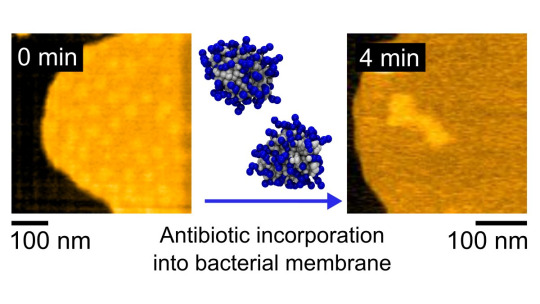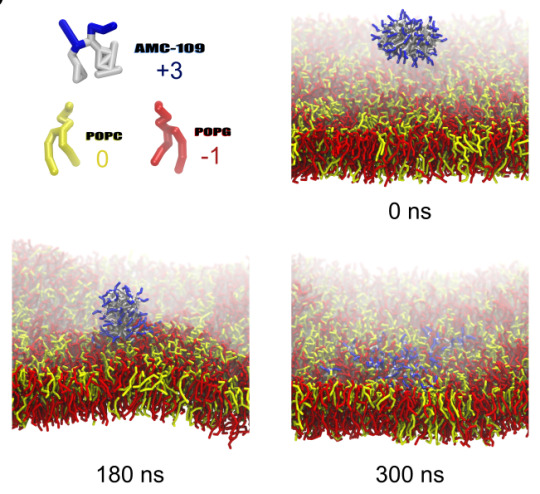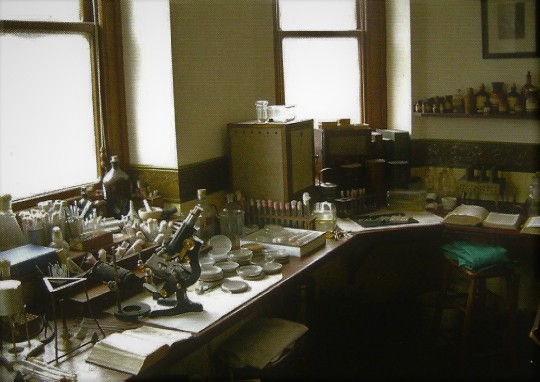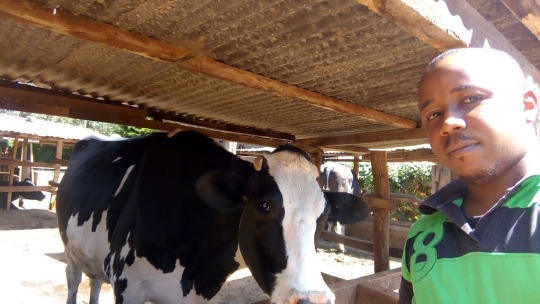#antibiotic
Text
We found a new antibiotic target in bacteria!!
It took almost 4 years, but the fruits of my postdoc research are finally here! In our paper (with me as the first author), just published in Nature Communications, we decipher a working mechanism of an antibiotic that targets the membrane of bacteria in an unprecedented way!
enhanced PDF: https://rdcu.be/dgj2d
web version: https://lnkd.in/eRpxr4jg

And how does it work?
The antibiotic AMC-109 first self-assembles into stable aggregates with a cationic surface. These aggregates then specifically target bacteria cells and insert into their membrane.
You can see the process how we simulated it in a computer on the figure below. Grey-Blue is the antibiotic, Red-Yellow are lipids that together form a membrane.
@jmelcr did this awesome simulation work! You are an amazing scientist, jmelcr! I love you and it seems our collaboration did not ruin our marriage. Not yet, anyway 😄.

After insertion into the bacterial membrane, the antibiotic dissolves membrane nanodomains affecting membrane function without formation of any pores or holes in the membrane.
Below is the series of high-speed atomic force microscopy images that shows the process of dissolution of membrane nanodomains. Yellow are the membranes extracted from bacteria laying flat on a hard surface (black). The membranes contain nanodomains (bright yellow) that are important in living bacteria for its survival. Addition of antibiotic dissolves them.

More studies will follow that use this new target in bacteria giving us an advantage over untreatable superbugs. I will keep you posted. And... keep your fingers crossed. It's research after all, so we never know if and how well it's going to work.
#science#women in science#research#postdoc#stem#biophysics#antimicrobial#antibiotic#amr#achievement#scientific journals#publication#breakthrough#original content
54 notes
·
View notes
Text
instagram
4 notes
·
View notes
Text
Dị ứng thuốc nếu không được chữa trị sớm và đúng cách có thể khiến bệnh nhân gặp phải nguy hiểm, đe dọa đến cả tình mạng. Vậy dị ứng thuốc là gì? Cách xử lý khi bị dị ứng thuốc ra sao?
#thuocdantoc#thuốc_dân_tộc#health#diung#diungthuoc#Allergy#Antibiotic#Medicine#health and wellness#healthcare#wellness#health & fitness#health tips
5 notes
·
View notes
Text
A protein found in human sweat may protect against Lyme disease
New Post has been published on https://thedigitalinsider.com/a-protein-found-in-human-sweat-may-protect-against-lyme-disease/
A protein found in human sweat may protect against Lyme disease


Lyme disease, a bacterial infection transmitted by ticks, affects nearly half a million people in the United States every year. In most cases, antibiotics effectively clear the infection, but for some patients, symptoms linger for months or years.
Researchers at MIT and the University of Helsinki have now discovered that human sweat contains a protein that can protect against Lyme disease. They also found that about one-third of the population carries a genetic variant of this protein that is associated with Lyme disease in genome-wide association studies.
It’s unknown exactly how the protein inhibits the growth of the bacteria that cause Lyme disease, but the researchers hope to harness the protein’s protective abilities to create skin creams that could help prevent the disease, or to treat infections that don’t respond to antibiotics.
“This protein may provide some protection from Lyme disease, and we think there are real implications here for a preventative and possibly a therapeutic based on this protein,” says Michal Caspi Tal, a principal research scientist in MIT’s Department of Biological Engineering and one of the senior authors of the new study.
Hanna Ollila, a senior researcher at the Institute for Molecular Medicine at the University of Helsinki and a researcher at the Broad Institute of MIT and Harvard, is also a senior author of the paper, which appears today in Nature Communications. The paper’s lead author is Satu Strausz, a postdoc at the Institute for Molecular Medicine at the University of Helsinki.
A surprising link
Lyme disease is most often caused by a bacterium called Borrelia burgdorferi. In the United States, this bacterium is spread by ticks that are carried by mice, deer, and other animals. Symptoms include fever, headache, fatigue, and a distinctive bulls-eye rash.
Most patients receive doxycycline, an antibiotic that usually clears up the infection. In some patients, however, symptoms such as fatigue, memory problems, sleep disruption, and body aches can persist for months or years.
Tal and Ollila, who were postdocs together at Stanford University, began this study a few years ago in hopes of finding genetic markers of susceptibility to Lyme disease. To that end, they decided to run a genome-wide association study (GWAS) on a Finnish dataset that contains genome sequences for 410,000 people, along with detailed information on their medical histories.
This dataset includes about 7,000 people who had been diagnosed with Lyme disease, allowing the researchers to look for genetic variants that were more frequently found in people who had had Lyme disease, compared with those who hadn’t.
This analysis revealed three hits, including two found in immune molecules that had been previously linked with Lyme disease. However, their third hit was a complete surprise — a secretoglobin called SCGB1D2.
Secretoglobins are a family of proteins found in tissues that line the lungs and other organs, where they play a role in immune responses to infection. The researchers discovered that this particular secretoglobin is produced primarily by cells in the sweat glands.
To find out how this protein might influence Lyme disease, the researchers created normal and mutated versions of SCGB1D2 and exposed them to Borrelia burgdorferi grown in the lab. They found that the normal version of the protein significantly inhibited the growth of Borrelia burgdorferi. However, when they exposed bacteria to the mutated version, twice as much protein was required to suppress bacterial growth.
The researchers then exposed bacteria to either the normal or mutated variant of SCGB1D2 and injected them into mice. Mice injected with the bacteria exposed to the mutant protein became infected with Lyme disease, but mice injected with bacteria exposed to the normal version of SCGB1D2 did not.
“In the paper we show they stayed healthy until day 10, but we followed the mice for over a month, and they never got infected. This wasn’t a delay, this was a full stop. That was really exciting,” Tal says.
Preventing infection
After the MIT and University of Helsinki researchers posted their initial findings on a preprint server, researchers in Estonia replicated the results of the genome-wide association study, using data from the Estonian Biobank. These data, from about 210,000 people, including 18,000 with Lyme disease, were later added to the final Nature Communications study.
The researchers aren’t sure yet how SCGB1D2 inhibits bacterial growth, or why the variant is less effective. However, they did find that the variant causes a shift from the amino acid proline to leucine, which may interfere with the formation of a helix found in the normal version.
They now plan to investigate whether applying the protein to the skin of mice, which do not naturally produce SCGB1D2, could prevent them from being infected by Borrelia burgdorferi. They also plan to explore the protein’s potential as a treatment for infections that don’t respond to antibiotics.
“We have fantastic antibiotics that work for 90 percent of people, but in the 40 years we’ve known about Lyme disease, we have not budged that,” Tal says. “Ten percent of people don’t recover after having antibiotics, and there’s no treatment for them.”
“This finding opens the door to a completely new approach to preventing Lyme disease in the first place, and it will be interesting to see if it could be useful for preventing other types of skin infections too,” says Kara Spiller, a professor of biomedical innovation in the School of Biomedical Engineering at Drexel University, who was not involved in the study.
The researchers note that people who have the protective version of SCGB1D2 can still develop Lyme disease, and they should not assume that they won’t. One factor that may play a role is whether the person happens to be sweating when they’re bitten by a tick carrying Borrelia burgdorferi.
SCGB1D2 is just one of 11 secretoglobin proteins produced by the human body, and Tal also plans to study what some of those other secretoglobins may be doing in the body, especially in the lungs, where many of them are found.
“The thing I’m most excited about is this idea that secretoglobins might be a class of antimicrobial proteins that we haven’t thought about. As immunologists, we talk nonstop about immunoglobulins, but I had never heard of a secretoglobin before this popped up in our GWAS study. This is why it’s so fun for me now. I want to know what they all do,” she says.
The research was funded, in part, by Emily and Malcolm Fairbairn, the Instrumentarium Science Foundation, the Academy of Finland, the Finnish Medical Foundation, the Younger Family, and the Bay Area Lyme Foundation.
#000#Analysis#Animals#antibiotic#Antibiotics#antimicrobial#approach#Bacteria#Biological engineering#Biology#Broad Institute#Cells#communications#data#Delay#Disease#disruption#engineering#eye#factor#fatigue#Finland#Foundation#Full#genetic#Genetics#genome#growth#how#human
2 notes
·
View notes
Text
Good News From Israel
Israel's Good News Newsletter to 29/1/23
In the 29th Jan 23 edition of Israel’s good news, the highlights include:
Israeli women are the 9th healthiest of 122 countries surveyed.
Israel has good news for IBD sufferers.
Israel added a record value of new medical benefits into its 2023 health basket.
For 60 years a Jerusalem charity has quietly supported the elderly in need.
A new Israeli natural sweetener has 70% less sugar for the same taste.
Israelis enjoy the world's best value Internet service.
A new Israeli factory is to mass-produce flexible solar panels.
An ancient site being excavated in Judea has three Biblical sources.
Read More: Good News From Israel

This week's positive Israel newsletter is full of healthy facts and innovations. Israel's subsidized medical treatments have just received a record annual increase of funds. There is news of current and potential treatments for Inflammatory bowel disease, bacterial infections, Parkinson's disease, personalized medicine, and the aging process. No wonder that Israeli women are among the world's healthiest. An Israeli charity looks after the health of the elderly; Sderot's trauma center is a global model of resilience; and the hearing-impaired have a new Israeli app. Meanwhile, Israelis are helping to sustain farmers in India and relieve war-weary civilians in Ukraine.
Israeli startups recently won awards for life-changing inventions. Israeli innovations protect wildlife from oil spills; save the world's coral reefs; convert polluting waste into food and fuel; make packaging that reduces CO2 emissions; create healthier sugar; develop and promote non-animal food alternatives; grow better yielding, sustainable crops and mass-produce flexible solar energy panels.
So come and enjoy our warm winter streets, mind-expanding museums and exhilarating musical events. Or pass on this newsletter to those who are only getting unhealthy messages about the Jewish State.
#aging#antibiotic#Bible#CO2#El Al#good news#health#IBD#India#Israel#Jazz#Jerusalem#Jewish#NATO#Parkinson’s trauma#solar#sugar#UAE#Ukraine#vegan
20 notes
·
View notes
Photo

Classification of antibiotics (anti-bacterial agents)
31 notes
·
View notes
Text
New nanonets target, trap, and kill specific bacteria
New nanonets target, trap, and kill specific bacteria
The nanonets could be used instead of antibiotics once fully developed.
Thoughts health innovators?
The nanonets could be used instead of antibiotics once fully developed.
The microscopic nets consist of antimicrobial peptides (AMPs), proteins that form a mesh when they detect certain chemicals in the bacterial cell membrane. Once the AMPs have attached themselves to the bacteria via these chemical sites, they attract other peptides, self-organizing to project long, interwoven tendrils to…

View On WordPress
#antibiotic#antibiotics#biology#biomimetic#healthinnovations#immunology#nanotechnology#resistance#resistant#science#superbug
4 notes
·
View notes
Text
#cayennepepper#cayenne#aphrodisiac#naturalaphrodisiac#antibiotic#libido#sexualpotency#healthyrecipes#recetasaludables
3 notes
·
View notes
Photo

Alexander Fleming Laboratory Museum
I must confess, several years after my visit, to still be finding myself disappointed in the Fleming Museum. Considering the historical significance of the location and the discovery that was made there, the whole experience was rather underwhelming. The entrance to the museum is a small, unkempt doorway just inside the gate of St Mary’s Hospital; the visitor must be buzzed in to enter, then climb up several floors to the reception, be relieved of £4 and then be promptly shown to the lab.
Fleming made the discovery of the action of penicillin after leaving out a plate of staphylococci bacteria in his lab before going on holiday for six weeks. On returning, he noticed a mould on the plate, and that the bacteria surrounding the mould had been destroyed. His chance discovery would lead to a revolution in antibiotics. The dusty, damp conditions of Fleming’s lab were perfect for the fungus to grow; the source of the initial spore is debated, though it seems likely it originated from a fungal lab on the floor below Fleming’s lab.

The lab has been reconstructed in the museum to appear much as it would have done at the time of the discovery; however, most of the items are replicas and were not owned or used by Fleming – which makes the decision to not allow photographs somewhat strange. After being given a brief spiel on Fleming in the lab, the next stop was a video, which was made in 1993 and seemed incredibly dated (the mention of the company SmithKline Beecham, which became GlaxoSmithKline in 2000, is rather a giveaway). The museum continued with a small room of shabby display boards retelling (in more detail) the story of the discovery and how the drug was mass-manufactured during WWII.

The visit finishes back in the reception with a chance to purchase souvenirs. It now becomes clear why one cannot take photos – they wanted to sell me a £5 photobook (more of a flimsy leaflet) of images of the lab. Or perhaps the £25 book? I opted for the 40p postcards which provided some of the images for this post. I understand that museums aren’t free to run, though given St Mary’s relies on volunteers to staff the museum, this felt a bit like a cash-grab where none of the money is reinvested in the museum. There are much better medical museums in London where you will spend more than 45 minutes, and are also better value for money...
#london#uk#england#museum#fleming#penicillin#alexander fleming#bacteria#mould#fungus#antibacterial#antibiotic#medicine#medical#lab#laboratory#manufacture#replica#reconstruction#history#travel#tourism#lundene#londinium
11 notes
·
View notes
Text
Antibiotics: When it’s best to avoid them and 10 natural alternatives
Antibiotics: When it’s best to avoid them and 10 natural alternatives
View On WordPress
0 notes
Text
18 hours difference of bacteria growth

How much can Staphylococcus aureus bacteria grow in less than a day? I add a few drops of bacteria into a fresh medium (basically a meat bouillon soup) and after 18 hours I count tens of billions bacteria per milliliter.
Literally, today I had 8x10^10 bacteria/ml. They grow like crazy when given the chance.
For the next 24 hours, I let them bath in antibiotics. Hehe!
#microbiology#bacteria#MRSA#staphylococcus#antibiotic#science#research#postdoc#crazy#stem#biophysics#academia#medical research#killing time#original content
9 notes
·
View notes
Text
Dị ứng thuốc kháng sinh xảy ra khi hệ miễn dịch phản ứng quá mức, gây hại cho cơ thể khi sử dụng hoặc tiếp xúc với các loại thuốc này. Vậy triệu chứng dị ứng thuốc kháng sinh là gì? Cách điều trị như thế nào?
#thuocdantoc#thuốc_dân_tộc#health#diung#diungthuockhangsinh#Allergy#Antibiotic#health and wellness#healthcare#wellness#health & fitness#health tips#healthyfood
5 notes
·
View notes
Text
Carmen Leitch - A Tropical Fruit With a Antimicrobial Effects:
BlighiaSapida #Okpu #TropicalFruit #Antimicrobial #AntibioticResistance #Antibiotic #Disease #Pathogenicity #Medicine #PlantBiology #Microbiology #Biology
#blighiasapida#okpu#tropicalfruit#antimicrobial#antibioticresistance#antibiotic#disease#pathogenicity#medicine#plantbiology#microbiology#biology
0 notes
Text
Antibiotic use on Kenya’s dairy farms is putting consumers and animals at risk
Dairy farmers often use antibiotics to keep their livestock healthy. They’re sometimes used as “quick fixes”, to avoid more costly management measures like regular disinfection, waste management, routine vaccination or provision of clean drinking water.
Animal husbandry now accounts for about two thirds of the global consumption of antibiotics. As livestock and fish production grows, by 2030 the…

View On WordPress
0 notes
Text
Amoxicillin And Ampicillin: A Valuable Asset For Pharmaceutical Companies in The Antibiotic Market
In the realm of antibiotics, Amoxicillin and Ampicillin are two stalwart medications that have saved countless lives. These drugs belong to the penicillin family, but they possess some distinct characteristics that set them apart.
The Role of Amoxicillin in Antibacterial Treatment
Amoxicillin, a stalwart antibiotic, serves as a cornerstone in the battle against bacterial infections. Its mechanism of action revolves around inhibiting bacterial growth by interfering with the formation of their cell walls. This unique approach renders Amoxicillin particularly effective against a broad spectrum of bacterial infections, encompassing those affecting the respiratory tract, urinary tract, and skin.
Benefits of Amoxicillin
Broad-spectrum Antibacterial Action: Amoxicillin's versatility is a boon for healthcare professionals as it allows them to combat a wide range of bacterial strains effectively. This broad spectrum of action makes it a valuable tool in the fight against infections.
High Efficacy: Thanks to its well-established track record, Amoxicillin often takes center stage as the first-line treatment option for various common infections. Its proven efficacy has made it a trusted choice for decades.
Minimal Side Effects: Patients can breathe easy when prescribed Amoxicillin, as it is generally well-tolerated with few adverse effects. This enhances patient compliance and contributes to a smoother recovery process.
Differentiating Ampicillin from Amoxicillin
Understanding Ampicillin's Mechanism of Action:
Ampicillin, much like its cousin Amoxicillin, is an antibiotic that zeroes in on bacteria by interfering with their cell walls. This action weakens the bacteria, eventually leading to their destruction. Ampicillin, however, has its own niche in the realm of antibiotics.
Spectrum of Activity: While both antibiotics have activity against some Gram-negative bacteria, their effectiveness varies. Ampicillin's primary focus lies in combating Gram-negative bacteria, making it an invaluable asset in the battle against these specific microorganisms.
Amoxicillin has a similar spectrum of activity to ampicillin, but it is often considered more effective against certain types of bacteria, including many strains of E. coli, H. influenzae, and Moraxella catarrhalis. This broader coverage makes amoxicillin a preferred choice in various infections, such as lower respiratory tract infections and some genitourinary infections.
Administration: Ampicillin takes a different route when it comes to administration. Unlike Amoxicillin, which is readily available in various oral forms like capsules and suspensions, Ampicillin is typically administered through injection. This injectable form is often employed in hospital settings.
Clinical Applications: Ampicillin shines in hospital settings, where it is used to tackle more severe infections. In contrast, Amoxicillin is frequently prescribed in outpatient settings due to its versatility and ease of oral administration.
Benefits of Amoxicillin and Ampicillin
Amoxicillin and Ampicillin offer numerous benefits, making them indispensable in the world of medicine:
1. Effectiveness
Both antibiotics are highly effective in treating bacterial infections, providing rapid relief to patients.
2. Versatility
The wide spectrum of activity of Amoxicillin and the unique applications of Ampicillin make them versatile tools in combating infections.
3. Accessibility
These antibiotics are readily available and are relatively cost-effective, making them accessible to a broad range of patients.
4. Proven Track Record
Amoxicillin and Ampicillin have a long history of successful use, cementing their status as trusted antibiotics.
Amoxicillin and Ampicillin are invaluable assets in the medical field, each with its distinct uses and benefits. Understanding their differences and applications is crucial for healthcare professionals and patients alike. Whether you are dealing with a respiratory infection, gastrointestinal ailment, or any other bacterial condition, these antibiotics play a vital role in promoting health and well-being.
We are dedicated to maintaining the highest standards in the pharmaceutical industry to meet the evolving needs of our clients.
As a leading pharmaceutical manufacturer, Wecaps unwavering commitment lies in producing top-notch raw materials (Amoxicillin and Ampicillin) for the global market.
Wecaps has two producing bases that meets the GMP standard: pharmaceutical and health products raw materials production bases, and ahealth products OEM factory. The raw materials production bases mainly produces nutration materials like: Ademethionine, Vitamin K2, PQQ etc. and API like Cefazoline Ceftriaxonesodium, etc. Our products have passed FDA and DMF registration, continue to expand the global market, and have obtained HALAL and KOSHER certifications.
We specialize in offering high-quality medical and healthcare products.
We provide customers with full worry-free processing services.
At the same time, Wecaps is also authorized to act on behalf of Chinese top pharmaceutical companies to sell their products to all over the world. The products including amoxicillin, ampicillin, chloramphenicol, azith-romycin and florfenol, etc. The annualtrade volume through Wecaps is over 1,000 tons. Wecaps provides customers with high quality medical and health products and OEM services at preferential prices.
We build long-term relationshipwith clients from over 40 countries.
With 40 years of focus in the field of empty capsules, we have become a trusted partner in the pharmaceutical industry. We' ve set up good cooperation with Pharmaceutical and Healthcare product company Lukang Pharma, CR Pharma, Kelun Group, YabaoPharma, Nepstar drug store, Huayuan Group, Sichuan Medco Pharma,Sinopharm etc.
0 notes